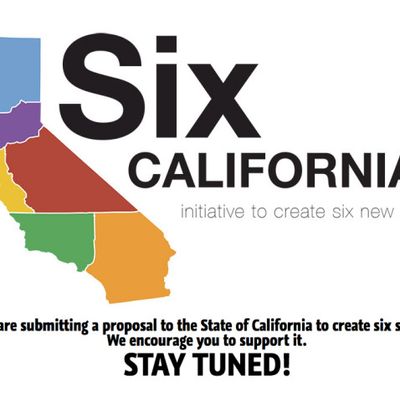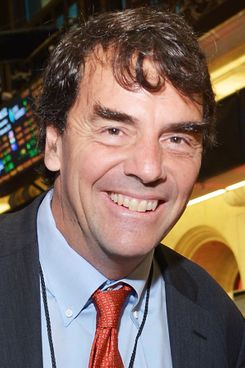
Over the years, techies in Silicon Valley have spent untold hours fantasizing about making the tech world its own self-sufficient sphere. Now, venture capitalist and all-around techno-enthusiast Tim Draper (whose school for aspiring tech heroes I profiled last year) is trying to make that fantasy happen.
Last year, Draper rolled out a “Six Californias” plan, a proposal that would split California into six separate states: Jefferson, North California, Silicon Valley, Central California, West California, and South California. Last week, California’s Secretary of State gave approval to the plan, which means it can now move into the signature-gathering phase in an attempt to have it appear on a November ballot. There is almost no chance the proposal will be enacted – even if it passed at the ballot box, Congress would need to approve it – but it’s the latest example of Silicon Valley’s isolationist mindset, and the ways the tech sector’s elite are trying to crowbar their way into national politics.
I spoke to Draper about the plan, what it would mean for inequality in California, and why he thinks Silicon Valley should be its own state.
So, what’s this all about?
Six Californias allows us a refresh. It allows the various states to have a sort of cooperative, competitive relationship with each other. It allows us Californians to have an easier way … it forces those states to compete for us and for our counties.
People in New York have been talking for years about separating New York City from Albany, where people tend to be more conservative and have a different kind of economy. Should other states do this?
Yes. I actually think New York should probably be three states. Upstate New York, New York City, and Long Island. And I suspect that Florida might be two states. Texas might be five, and Illinois might be two or three. I think we might end up with 60 states when all is said and done.
People are not well-represented right now. In California in particular, it’s a large state, very unwieldy, [a] lot of different interests. Government is trying to be all things to be all people, and they’re failing at everything. They’re not doing any good for anybody.

There was one piece that showed that this plan would create the highest-income state and the most impoverished state in the country, with Silicon Valley being the richest and Central California being the poorest. Is inequality something you worry about?
It’s interesting, the way it’s coming out is that the people in Central California, and the people in Jefferson, who would be the poorest states, are the ones who are the most enthusiastic supporter of Six Californias. They are the have-nots under the current regime.
How do you quantify that enthusiasm? Is there poll data?
Jefferson’s been trying to break off from California for quite a while. In all my exposure – I’ve had huge influx of activity coming from Central California saying, “Yes, please, break us away from Sacramento.” A lot of it has to do with water rights. I believe that all six states will be better off than they are today. I mean, if you have a state that charges the most, and provides the worst services, even if you create six average states, you’re doing way better than you would be by using the status quo.
I’ve spoken with a lot of technologists in Silicon Valley about politics, and a thing they often complain about is the way that the economic gains that are created in the Valley aren’t necessarily staying there – they’re going to farm subsidies in Fresno and down to L.A. to support the social safety net. Is part of the motivation for this plan to keep what’s created in Silicon Valley in Silicon Valley?
You know, it’s interesting. If you really follow where that money goes, it doesn’t really do what you’re saying it does. It’s very important to actually follow that money. When you know that we used to get 26 percent on infrastructure, now we get 3 percent on infrastructure, figure out where that money goes.
Where does it go? You tell me!
No, I just want you to do an investigative piece on where that money goes.
Do you imagine Silicon Valley being a place where you would have very little regulation on commerce and loose rules when it comes to things like intellectual property law?
I think Silicon Valley and the other states will all have whatever the constituents want. Each one will have its own way of operating and managing, and the good news is that the issues that are near and dear to the hearts of Silicon Valley, and Central California will be better represented, because they’re closer to their government. Our government is too distant and out of touch.
We really have a problem, a serious problem, in California, and we cannot leave it the way it is. We are the worst state and getting to be even worse. And something has to happen.
What do you mean by “the worst state”?
We spend the most and get the least. We spend the most on education, and we’re 46th in education. [Ed. note: California currently ranks 35th in per-pupil spending, according to the Census Bureau, and its fourth-graders ranked 47th in the nation in reading and math last year, according to the NAEP.] We spend among the most for prisons, and we have among the worst.
The issues that you just cited – prison and education reform – there are much easier ways to deal with those problems than re-drawing state boundaries, aren’t there?
Wait a second. We are spending the most and we’re 46th. We could keep spending more and getting worse, is that what you’re saying?
Okay, but how would redrawing the state lines help?
People would be closer to their government. It will be their government. Right now they feel distant.
What’s the connection between feeling close to government and school outcomes changing?
All the way across the country, in general, there’s some more research you can do. In general, education is better when a state is smaller.
I wrote a piece a few weeks ago about Silicon Valley and politics. One thing I found was that there are two camps of Silicon Valley technologists – reformers who want to participate in the system and get their voices heard through official channels, and then there seem to be people like you and Balaji Srinivasan and Chamath Palihapitiya, who want to break away. Is the work you’re doing with Six Californias challenging the reform methods of your colleagues?
We are our government. We the people. We need to make that democracy work as well as it possibly can, and I’m working within the system to create something that allows us to improve that democracy.
As you may know, in San Francisco, tech jobs only account for 8 percent of the private-sector jobs in the city. Do you think it’s problematic that an entire state would be named after an industry that only supports a fraction of the jobs and economic growth within its borders?
Once the states are created, they can call themselves whatever they want. There might be people in San Francisco who think this should be called the Bay Area, or whatever. But [under the Six Californias plan,] it’s also possible for counties to move to other states. So if San Francisco felt like they were not appropriately represented in something called Silicon Valley, they could move.
Why stop at 60 states? Should Ohio separate Cleveland from Cincinnati? Should every urban environment be its own state?
This is our democracy. If people feel they are taxed without being represented, or they’re not being properly represented, they should do something about it.
How much money are you putting into this effort personally?
As little as possible.





























